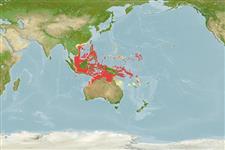Environment: milieu / climate zone / depth range / distribution range
Ecologia
marinhas associadas(os) a recifes; não migratória; intervalo de profundidade 5 - 147 m (Ref. 90102). Tropical; 22°N - 20°S, 104°E - 172°E
Indo-West Pacific: Philippines, Indonesia, New Guinea, northeastern Australia (Cape York to northern Great Barrier Reef) Belau, Truk, Caroline Islands, Marshall Islands, and the Solomon Islands. Reported from Malaysia (Ref. 5756).
Length at first maturity / Tamanho / Peso / Idade
Maturity: Lm ?, range 42 - ? cm
Max length : 75.0 cm TL macho/indeterminado; (Ref. 5222); peso máx. Publicado: 1.2 kg (Ref. 40637)
Espinhos dorsais (total): 7 - 8; Raios dorsais moles (total): 10-12; Espinhos anais 3; Raios anais moles: 8.
Inhabits drop-offs and steep channel slopes (Ref. 9710). Very little has been published on its biology. Reported to forage in groups of two or three for rock- and sand living crustaceans and fishes. Rare in most areas (Ref. 9710). In the Hong Kong live fish markets (Ref. 27253).
Life cycle and mating behavior
Maturidade | Reprodução | Desova | Ovos | Fecundidade | Larvas
Heemstra, P.C. and J.E. Randall, 1993. FAO Species Catalogue. Vol. 16. Groupers of the world (family Serranidae, subfamily Epinephelinae). An annotated and illustrated catalogue of the grouper, rockcod, hind, coral grouper and lyretail species known to date. Rome: FAO. FAO Fish. Synop. 125(16):382 p. (Ref. 5222)
Categoria na Lista Vermelha da IUCN (Ref. 130435)
Ameaça para o homem
Reports of ciguatera poisoning (Ref. 5222)
Utilização humana
Pescarias: pouco comercial
Mais informação
ReferênciasAquaculturaPerfil para aquaculturaEstirpesGenéticaElectrophoresesHereditariedadeDoençasProcessamentoNutrientsMass conversion
ColaboradoresFotografiasStamps, Coins Misc.SonsCiguateraVelocidadeTipo de nataçãoÁrea branquialOutras referênciasCérebrosVisão
Ferramentas
Relatórios especiais
Descarregue XML
Fontes da internet
Estimates based on models
Preferred temperature (Ref.
123201): 26.6 - 29.3, mean 28.7 °C (based on 1890 cells).
Phylogenetic diversity index (Ref.
82804): PD
50 = 0.5078 [Uniqueness, from 0.5 = low to 2.0 = high].
Bayesian length-weight: a=0.01023 (0.00643 - 0.01629), b=3.03 (2.90 - 3.16), in cm total length, based on LWR estimates for this species & (Sub)family-body (Ref.
93245).
Nível Trófico (Ref.
69278): 4.0 ±0.66 se; based on food items.
Resiliência (Ref.
120179): Baixo, tempo mínimo de duplicação da população 4,5 - 14 anos (Preliminary K or Fecundity.).
Fishing Vulnerability (Ref.
59153): Moderate to high vulnerability (50 of 100).
Nutrients (Ref.
124155): Calcium = 33.3 [19.4, 63.3] mg/100g; Iron = 0.563 [0.294, 0.941] mg/100g; Protein = 19 [17, 21] %; Omega3 = 0.162 [0.105, 0.257] g/100g; Selenium = 53.9 [31.7, 98.6] μg/100g; VitaminA = 42.2 [14.7, 134.2] μg/100g; Zinc = 0.813 [0.559, 1.195] mg/100g (wet weight);
